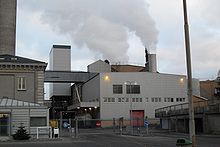Nakskov
| Nakskov | ||||
|
||||
| Basic data | ||||
|---|---|---|---|---|
| State : |
|
|||
| Region : | Sjælland | |||
|
Municipality (since 2007) : |
Lolland | |||
| Coordinates : | 54 ° 50 ′ N , 11 ° 10 ′ E | |||
| Founded: | 1266 | |||
|
Population : (2020) |
12,707 | |||
| Postal code : | 4900 Nakskov | |||
 View from the harbor |
||||
Nakskov is the largest town in the municipality of Lolland on the Danish island of Lolland . It is located at the western end of the island by the Nakskov Fjord and has 12,707 inhabitants (as of January 1, 2020).
A town partnership with Eckernförde in Germany has existed since 1969 .
history
Traces of Neolithic settlement have been found in the vicinity of the city. However, the exact date of foundation of the place is unknown. Nakskov received city rights in 1266. The location at the end of the fjord was ideal for the construction of a port. Due to the rich herring deposits in the Langelandsbelt, the city came to some prosperity.
At the beginning of the 16th century, the Danish king built Denmark's first naval shipyard on the island of Slotø in the fjord, which also served as a fortress to protect the city against enemy ships. During the Danish-Luebian War , a naval battle broke out in front of Nakskov in 1510 after the Lübeckers had plundered the city. At that time Nakskov was one of the largest Danish cities.
The wars with Sweden in the 17th century led to a siege and bombardment of the city by the Swedish fleet for several months in 1659.
In the following centuries Nakskov lost its importance. Although it remained one of the most important export ports for Lolland's agriculture, trade and later industry played only a minor role on Lolland compared to other Danish cities.
In 1916 a shipyard was built by the shipowner and industrialist Hans Niels Andersen . The shipyard became the city's most important industrial employer in the following decades. From 1920 to 1987 over 200 ships were built in Nakskov, many of them for the shipyard owner Det Østasiatiske Kompagni (East Asiatic Company), as well as the sailing training ship Danmark .
In 2007 Nakskov was united with several municipalities to form the Lolland municipality.
economy
Since the shipyard was closed, Vestas has been manufacturing rotor blades for wind generators on the former shipyard site . Another important economic factor is the sugar factory of Nordic Sugar (formerly Danisco Sugar), now part of Nordzucker , which processes around 12,000 tons of sugar beet per day and is the largest of the two (Nakskov and Nykobing / Falster) Danish sugar factories. The port is mainly used for the export of grain. Since only ships with a draft of up to 5.70 m can call at the port, only smaller ships can be loaded. As in almost all port cities in Denmark, there are extensive berths for yachts .
Tourism is an increasingly important economic factor .
traffic
The ferry connection to the neighboring island of Langeland was relocated from the city to the north-western suburb of Tårs a few years ago . The motorway from Rødbyhavn (ferry to Puttgarden ) to Copenhagen is about 25 km away at Maribo . The city is connected to the railway network via the private Lollandsbanen . This operates the line from Nakskov via Maribo to Nykøbing Falster .
Attractions
- The main attraction of the city is the Gothic St. Nikolai Church, which was built in the 15th century. Some parts still come from the previous building from the 13th century.
- In the old town there are some houses from the 16th to 18th centuries.
- Since the sugar factory is important to the city, the Danish Sugar Museum was established here.
- The history of the shipyard is the main theme of the Ship and Maritime Museum. It is located in the port administration building.
- In addition to the old shipyard area, a Soviet submarine of Project 613 built in 1953 could be viewed between 1997 and April 2011 .
- Nakskov is also home to one of Denmark's oldest Jewish cemeteries.
sons and daughters of the town
- Fritz Hansen (1847–1902), Danish cabinet maker and company founder
- Johan Ludwig Jensen (1859–1925), Danish mathematician
- Jørgen Skafte Rasmussen (1878–1964), Danish engineer and industrialist
- Stefan Wenzel (* 1962), German politician ( Bündnis 90 / Die Grünen ), Lower Saxony Minister for Environment, Energy and Climate Protection since 2013 and Deputy Prime Minister in the Weil I cabinet
- Helle Helle (* 1965), writer
- Mette Jacobsen (* 1973), swimmer and Olympian
- Anna Sofie Hartmann (* 1984), director and screenwriter
Individual evidence
- ↑ a b Statistics Banks -> Befolkning og valg -> BY1: Folketal January 1st efter byområde, alder og køn (Danish)
- ↑ Historical view from 1729: Ichnographia Nakscoviae munite Laalandiae oppidi, ut et stationum ac operum quibus primum a ... com. Wran gelis obsessa et oppugnata tandem ab ... com. Steenbockio ad deditionem coacta fuit ... 16 julii 1659 . ( Digitized version )
- ↑ U-båden ud på sin sidste rejse. April 15, 2011, accessed August 12, 2011 (Danish).
Web links
- Nakskov Havn , on lolland.dk (municipality homepage)
- Harbor check Lolland-Faster-Mön Segeln-Magazin No. 8/2008, accessed December 27, 2008 (PDF file; 677 kB)
- Danmarks Købstæder: Nakskov (on byhistorie.dk, Danish)



